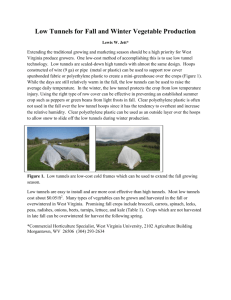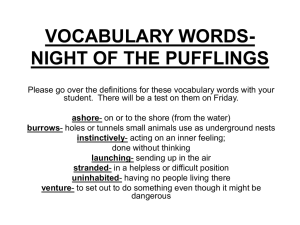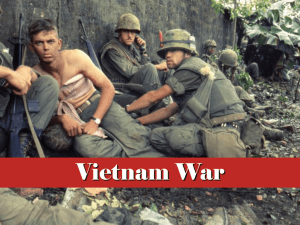Cu Chi Tunnels
advertisement
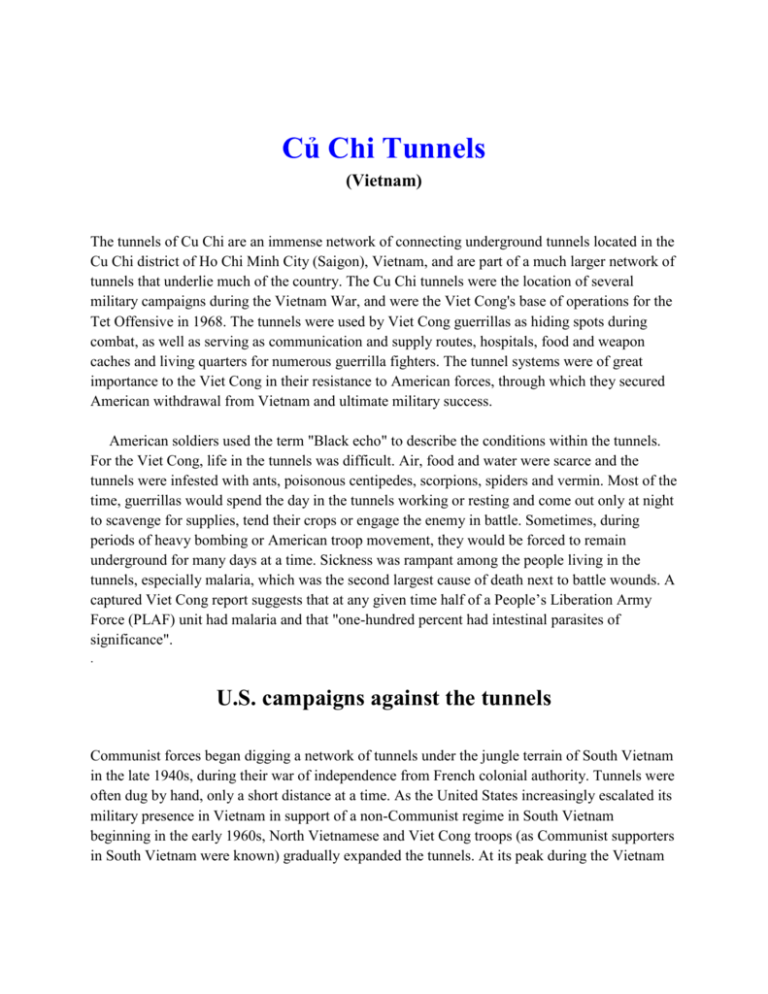
Củ Chi Tunnels (Vietnam) The tunnels of Cu Chi are an immense network of connecting underground tunnels located in the Cu Chi district of Ho Chi Minh City (Saigon), Vietnam, and are part of a much larger network of tunnels that underlie much of the country. The Cu Chi tunnels were the location of several military campaigns during the Vietnam War, and were the Viet Cong's base of operations for the Tet Offensive in 1968. The tunnels were used by Viet Cong guerrillas as hiding spots during combat, as well as serving as communication and supply routes, hospitals, food and weapon caches and living quarters for numerous guerrilla fighters. The tunnel systems were of great importance to the Viet Cong in their resistance to American forces, through which they secured American withdrawal from Vietnam and ultimate military success. American soldiers used the term "Black echo" to describe the conditions within the tunnels. For the Viet Cong, life in the tunnels was difficult. Air, food and water were scarce and the tunnels were infested with ants, poisonous centipedes, scorpions, spiders and vermin. Most of the time, guerrillas would spend the day in the tunnels working or resting and come out only at night to scavenge for supplies, tend their crops or engage the enemy in battle. Sometimes, during periods of heavy bombing or American troop movement, they would be forced to remain underground for many days at a time. Sickness was rampant among the people living in the tunnels, especially malaria, which was the second largest cause of death next to battle wounds. A captured Viet Cong report suggests that at any given time half of a People’s Liberation Army Force (PLAF) unit had malaria and that "one-hundred percent had intestinal parasites of significance". . U.S. campaigns against the tunnels Communist forces began digging a network of tunnels under the jungle terrain of South Vietnam in the late 1940s, during their war of independence from French colonial authority. Tunnels were often dug by hand, only a short distance at a time. As the United States increasingly escalated its military presence in Vietnam in support of a non-Communist regime in South Vietnam beginning in the early 1960s, North Vietnamese and Viet Cong troops (as Communist supporters in South Vietnam were known) gradually expanded the tunnels. At its peak during the Vietnam War, the network of tunnels in the Cu Chi district linked VC support bases over a distance of some 250 kilometers, from the outskirts of Saigon all the way to the Cambodian border. The tunnels of CU Chi did not go completely unnoticed by U.S. officials. They recognized the advantages that the Viet Cong held with the tunnels, and accordingly launched several major campaigns to search out and destroy the tunnel system. Among the most important of these were Operation Crimp and Operation Cedar Falls. Operation Crimp began on January 7, 1966, with B52 bombers dropping 30-ton loads of high explosive onto the region of Cu Chi, effectively turning the once lush jungle into a pockmarked moonscape. Eight thousand troops from the U.S. 1st Infantry Division, 173rd Airborne Brigade, and the 1st Battalion, Royal Australian Regiment combed the region looking for any clues of PLAF activity. A trap door on the jungle floor leads down into the Củ Chi tunnels. Closed and camouflaged, it is almost undetectable. The operation was, for the most part, unsuccessful. On the occasion when troops found a tunnel, they would often underestimate its size. Rarely would anyone be sent in to search the tunnels, as it was so hazardous. The tunnels were often rigged with explosive booby traps or punji stake pits. A booby trap with bamboo spikes. The two main responses in dealing with a tunnel opening were to flush the entrance with gas or water to force the guerrillas into the open, or to toss a few grenades down the hole and "crimp" off the opening. The clever design of the tunnels along with the strategic use of trap doors and air filtration systems rendered American technology ineffective. However, an Australian specialist engineering troop, 3 Field Troop, under the command of Captain Sandy MacGregor did venture into the tunnels which they searched exhaustively for four days, finding ammunition, radio equipment, medical supplies and food as well as signs of considerable Viet Cong presence. One of their number, Corporal Bob Bowtell died when he became trapped in a tunnel that turned out to be a dead end. However the Australians pressed on and revealed, for the first time, the immense military significance of the tunnels. At an International Press Conference in Saigon shortly after Operation Crimp, MacGregor referred to his men as Tunnel Ferrets. An American journalist, having never heard of ferrets, used the term Tunnel Rats and it stuck. Following his troop's discoveries in Cu Chi, Sandy MacGregor was awarded a Military Cross. From its mistakes, and the Australians' discoveries, U.S. command realized that they needed a new way to approach the dilemma of the tunnels. A general order was issued by General Williamson, the Allied Forces Commander in South Vietnam, to all Allied forces that tunnels had to be properly searched whenever they were discovered. They began training an elite group of volunteers in the art of tunnel warfare, armed only with a gun, a knife, a flashlight and a piece of string. These specialists, commonly known as "tunnel rats", would enter a tunnel by themselves and travel inch-by-inch cautiously looking ahead for booby traps or cornered PLAF. There was no real doctrine for this approach and despite some very hard work in some sectors of the Army and MACV (Military Assistance Command, Vietnam) to provide some sort of training and resources, this was primarily a new approach that the units trained, equipped and planned for themselves. Despite this revamped effort at fighting the enemy on its own terms, U.S. operations remained largely unsuccessful at eliminating the tunnels. In 1967, General William Westmoreland tried launching a larger assault on Cu Chi and the Iron Triangle. Called Operation Cedar Falls, it was, in principle, exactly the same as Operation Crimp, but with 30,000 troops instead of the 8,000. On January 18, tunnel rats from the 1st and 5th Infantry uncovered the Viet Cong district headquarters of Cu Chi containing half a million documents concerning all types of military strategy. Among the documents were maps of U.S. bases, detailed accounts of PLAF movement from Cambodia into Vietnam, lists of political sympathizers, and even plans for a failed assassination attempt on Robert McNamara. With this one exception, Operation Cedar Falls failed to achieve its objective of destroying the communist stronghold in the region. By 1969, B-52s were freed from bombing North Vietnam and started "carpet bombing" Cu Chi and the rest of the Iron Triangle. Ultimately it proved successful but futile. Towards the end of the war, the tunnels were so heavily bombed that some portions actually caved in and other sections were exposed. But by that time, they had succeeded in protecting the local guerrilla units in "surviving to fight another day". Throughout the course of the war, the tunnels in and around Cu Chi proved to be a source of frustration for the U.S. military in Saigon. The Viet Cong had been so well entrenched in the area by 1965 that they were in the unique position of locally being able to control where and when battles would take place. By helping to covertly move supplies and house troops, the tunnels of Cu Chi allowed guerrilla fighters in their area of South Vietnam to survive, help prolong the war and increase American costs and casualties until their eventual withdrawal in 1972, and the final defeat of the Republic of Vietnam in 1975. The 75-mile (121 km)-long complex of tunnels at Cu Chi has been preserved by the government of Vietnam, and turned into a war memorial park. The tunnels are a popular tourist attraction, and visitors are invited to crawl around in the safer parts of the tunnel system. Some tunnels have been made larger to accommodate the larger size of Western tourists, while low-power lights have been installed in several of them to make traveling through them easier and booby traps have been clearly marked. Underground conference rooms where campaigns such as the Tet Offensive were planned in 1968 have been restored, and visitors may enjoy a simple meal of food that Viet Cong fighters would have eaten. Above-ground attractions include caged monkeys, vendors selling souvenirs, and a shooting range where visitors can fire a number of assault rifles, such as the M16 rifle or AK-47, as well as a light machine gun like the M60. Củ Chi tunnels A command center in the tunnels. Visitors to the complex can eat meals underground, sampling foods that the underground Viet Cong fighters had eaten, such as rice Tour guide showing how the tunnel works. Visitors entering tunnel system. Tourists can fire a variety of Vietnam War era weapons at the shooting range. [Source: http://en.wikipedia.org/wiki/Cu_Chi_Tunnels Nov 2011 ++]


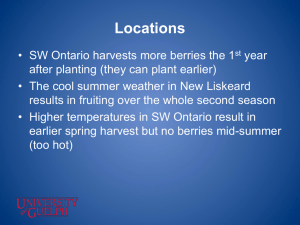
![vietnam[1].](http://s2.studylib.net/store/data/005329784_1-42b2e9fc4f7c73463c31fd4de82c4fa3-300x300.png)
